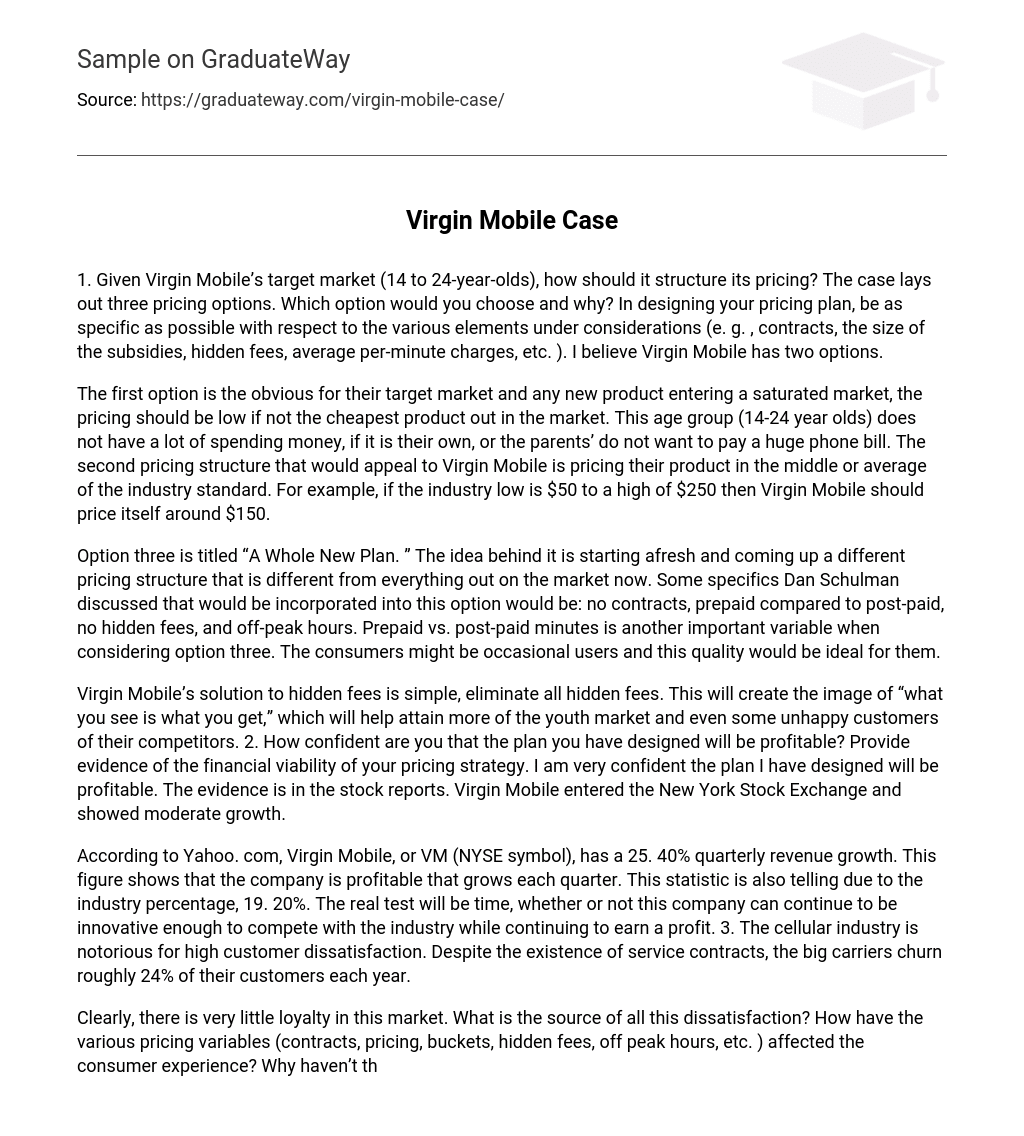1. Virgin Mobile needs to determine the best pricing structure for its target market of 14 to 24-year-olds. The case presents three pricing options to consider. Which option do you think is the most suitable and why? When creating your pricing plan, be detailed in terms of factors such as contracts, subsidy amounts, additional fees, average per-minute charges, etc. Personally, I believe Virgin Mobile has two potential options.
The optimal pricing strategy for Virgin Mobile’s target market, which comprises individuals aged 14-24, would be to provide a low-cost alternative. In an oversaturated market, it is crucial for a new product to possess competitive pricing, even if it means being the most affordable choice available. This specific age group usually lacks significant disposable income, and their parents may also be unwilling to pay high phone bills. Alternatively, Virgin Mobile might contemplate positioning their product within the industry’s average price range. For example, if the standard in the industry ranges from $50 to $250, Virgin Mobile could set their prices at approximately $150.
Option three, also known as “A Whole New Plan,” focuses on the concept of starting fresh and introducing a unique pricing structure that stands out from existing options available in the market. During the discussion, Dan Schulman mentioned several key features that would be included in this option, such as the absence of contracts, a prepaid approach rather than post-paid, transparency without hidden fees, and availability of off-peak hours. When evaluating option three, it is important to consider the distinction between prepaid and post-paid minutes, as this aspect is particularly beneficial for occasional users.
Virgin Mobile is aiming to eliminate all hidden fees, in order to establish a transparent pricing model that resonates with the youth market and appeals to dissatisfied customers of competitors. I have great confidence in the profitability of my designed plan, as evident through the stock reports. Virgin Mobile’s moderate growth was demonstrated when it entered the New York Stock Exchange.
According to Yahoo.com, Virgin Mobile (NYSE symbol: VM) has experienced a 25.40% growth in revenue on a quarterly basis. This indicates that the company is consistently profitable and shows continuous growth. It is significant because it surpasses the industry average of 19.20%. The ultimate challenge for Virgin Mobile will be to sustain its innovative approach in order to compete with other companies in the industry while still generating profits. Additionally, it is worth noting that the cellular industry is notorious for having a high level of customer dissatisfaction, leading to approximately 24% customer turnover for major carriers despite the presence of service contracts.
In this market, there is minimal loyalty, which raises questions about the source of dissatisfaction and the impact of pricing variables on the consumer experience. These variables include contracts, pricing, buckets, hidden fees, and off peak hours. The big carriers have not responded adequately to customer dissatisfaction, leading to a lack of trust in the industry’s pricing plans. Young people specifically recognize the presence of numerous hidden charges and feel resentful. The modern consumer is knowledgeable and detests feeling manipulated.
Other factors that contribute to dissatisfaction with cellular providers include contracts, pricing, buckets, hidden fees, and off-peak hours. Many individuals dislike the feeling of being tied down to a specific provider and are deterred by the rigorous credit check process. Furthermore, hidden costs such as taxes, universal service charges, and various one-time expenses add to this discontent. Additionally, numerous plans impose predetermined “buckets” of minutes, requiring customers to choose and sign up for a specific amount. However, exceeding the allotted bucket of minutes often results in severe penalties in the form of exorbitant rates.
Two factors have affected the consumer experience: worries about both on and off peak hours, as well as dissatisfaction with different pricing methods. Initially, the off-peak hours began at 6:00pm but have gradually shifted to 9:00pm. The major players in the industry – AT&T, Cingular, and Verizon – hold a considerable market share which gives them a monopoly over the cell phone sector. As a result, they lack motivation to address customer dissatisfaction.





